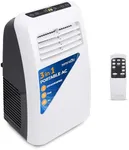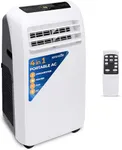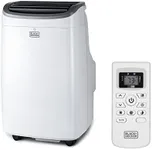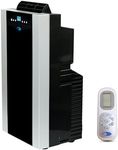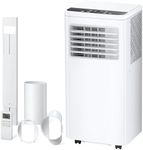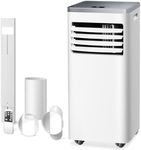Buying Guide for the Best Portable Air Conditioner
Choosing a portable air conditioner can make a big difference in your comfort during hot weather. The right model will cool your space efficiently, be easy to move, and fit your needs without wasting energy. To find the best fit, it's important to understand the main features and specifications that affect performance and usability. By focusing on your room size, how you plan to use the unit, and your preferences for convenience, you can narrow down your options and make a smart choice.Cooling Capacity (BTU)Cooling capacity, measured in BTUs (British Thermal Units), tells you how much heat the air conditioner can remove from a room per hour. This is crucial because a unit that's too weak won't cool your space, while one that's too strong may cycle on and off too quickly, wasting energy and not removing humidity well. Small rooms (up to 200 sq ft) usually need 8,000-10,000 BTU, medium rooms (200-400 sq ft) need 10,000-14,000 BTU, and larger spaces may require more. To pick the right one, measure your room and match it to the recommended BTU range for efficient cooling.
Size and PortabilityThe size and portability of a portable air conditioner affect how easily you can move and store it. Some units are compact and lightweight, making them easy to roll from room to room, while others are bulkier and heavier. If you plan to move the unit often or have limited space, look for a smaller, lighter model with sturdy wheels and handles. If it will mostly stay in one place, a larger unit may be fine.
Noise LevelNoise level, usually measured in decibels (dB), indicates how loud the air conditioner will be when running. This is important if you plan to use it in a bedroom, office, or any quiet space. Lower dB values mean quieter operation. Units under 50 dB are considered quiet, while those above 60 dB may be noticeable. If you’re sensitive to noise or need a peaceful environment, choose a model with a lower noise rating.
Energy EfficiencyEnergy efficiency shows how much cooling you get for the electricity used. Look for the Energy Efficiency Ratio (EER) or check for an Energy Star rating. Higher EER values mean better efficiency. If you plan to use the air conditioner often or for long periods, a more efficient model will save on electricity and be better for the environment.
Drainage and DehumidificationPortable air conditioners remove moisture from the air as they cool. Some units have self-evaporating systems that handle most of the water, while others require you to empty a water tank or connect a drain hose. If you live in a humid area or want less maintenance, look for a self-evaporating or continuous drain option. If humidity is a big concern, check the dehumidification rate (measured in pints per day) to see how much moisture the unit can remove.
Control and FeaturesModern portable air conditioners come with various controls and features, such as remote controls, programmable timers, sleep modes, and smart connectivity. These features add convenience and can help you customize cooling to your schedule. If you want to set the unit to turn on or off automatically, or control it from your phone, look for these options. If you prefer simple operation, a basic model with manual controls may be enough.
Ventilation and InstallationAll portable air conditioners need to vent hot air outside, usually through a window. The type and size of the included window kit can affect how easy it is to set up. Some kits fit a wide range of windows, while others are more limited. If you have unusual windows or plan to move the unit between rooms, check that the venting system will work for your space.
